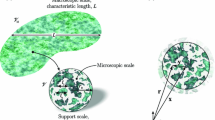Abstract
We investigate convective-diffusive transport of a solute through a medium with properties that can be externally modulated in space and time. In particular, we focus on the effect of a front—a sharp transition in the convective velocity (v) and diffusivity (D)—on the evolution of the solute concentration profile. Numerical results show that by suitably moving the front during the process an anti-dispersive effect may be realized, in which the solute accumulates in a thin region close to the moving boundary. Our computations take into account the realistic case of a front having a small but finite thickness, and we find that the width of the concentration profile scales as\(\left( {1/\sqrt {Pe} } \right)\), where Pe is the Péclet number. This is in sharp contrast to the 1/Pe scaling observed for the ideal case of the singular front assumed in previous work. The effect of the thickness of the front and the magnitude of the drop inv andD, on the solute concentration profile has also been studied. These results are relevant in order to implement and optimize protocols that apply an externally controlled moving boundary for the purpose of separation.
We also present experimental results characterizing solute transport across a stationary front, expected to display many features needed in a model for moving fronts. The concentration profile of electrophoretically mobile BSA-FITC within the boundary layer at a polyacrylamde gel-buffer interface were visualized by epifluorescence microscopy. Measured boundary layer thickness exceeded that predicted for even a finite interface, indicating that the length scale associated with real boundaries is relevant to the modeling problem.
Similar content being viewed by others
References
Bhaskar, R.K., R.V. Sparer, and K.J. Himmelstein, “Effect of an Applied Electric Field on Liquid Crystalline Membranes: Control of Permeability,”J. Membrane Sci.,24, 83–96 (1985).
Brenner, H., “The Diffusion Model of Longitudinal Mixing in Beds of Finite Length. Numerical Values,”Chem. Engng Sci.,44, 827–840 (1962).
Brzezinski, W., W.M.J. van Gelder, P. Mendelewski, and P. Kolster, “Polyacrylamide Gel Electrophoresis of Wheat Gliadins: The Use of a Moving Boundary for Improved Resolution,”Euphytica,40, 207–212, (1989).
Chrambach, A., “Unified View of Moving Boundary Electrophoresis: Practical Implications (Plenary Lecture),”J. Chromatogr.,320, 1–14, (1985).
Chu, G., D. Vollrath, and R.W. Davis, “Separation of Large DNA Molecules by Contour-Clamped Homogeneous Electric Fields,”Science,234, 1582–1585 (1986).
Danckwerts, P.V., “Continuous Flow Systems. Distribution of Residence Times,”Chem. Engng Sci.,2, 1–18, (1953).
de Gennes, PG. and J. Prost,The Physics of Liquid Crystals (2nd Ed.). Clarendon Press, Oxford, 1993.
Deinhammer, R.S., E.-Y. Ting, and M.C. Porter, “Dynamic Modification of Separations Using Electrochemically Modulated Liquid Chromatography,”Anal. Chem.,67, 237–246 (1995).
Gallagher, S.R. and J.A. Smith,Current Protocols in Molecular Biology, John Wiley and Sons Inc.,2. 10.2.19, 1993.
Ghatak-Roy, A.R. and C.R. Martin, “Electromodulated Ion Exchange Chromatography,”Anal. Chem.,58, 1574–1575 (1986).
Grimshaw, P.E., A.J. Grodzinsky, M.L. Yarmush, and D.M. Yarmush, “Dynamic Membranes for Protein Transport: Chemical and Electrical Control,”Chem. Engng. Sci.,44, 827–840 (1989).
Ivory, C.F. and W.A. Gobic, “Continuous Counteracting Chromatographic Electrophoresis,”Biotechnol. Prog.,6, 21–32 (1990).
Krüger, G.J., “Diffusion in Thermotropic Liquid Crystals,”Phys. Rep.,82(4), 229–269 (1982).
Leonard, B.P., “A Stable and Accurate Convective Modelling Procedure Based on Quadratic Upstream Interpolation,”Comp. Meth. Appl. Mech. Eng.,19, 59–98 (1979).
Locke, B.R. and P. Arce, “Applications of Self-Adjoint Operators to Electrophoretic Transport, Enzyme Reactions, and Microwave Heating Problems in Composite Media-I. General Formulation,”Chem. Engng Sci.,48, 1675–1686 (1993a).
Locke, B.R., P. Arce, and Y. Park, “Applications of Self-Adjoint Operators to Electrophoretic Transport, Enzyme Reactions, and Microwave Heating Problems in Composite Media-II. Electrophoretic Transport in Layered Membranes,”Chem. Engng Sci.,48, 4007–4022 (1993).
Ly, Y. and Y.-L. Cheng, “Electrically-Modulated Variable Permeability Liquid Crystalline Polymeric Membrane,”J. Membrane Sci.,77, 99–112 (1993).
Moseley, M.E. and A. Loewenstein, “Anistropic Translational Diffusion of Methane and Chloroform in Thermotropic Nematic and Smectic Liquid Crystals,”Mol. Cryst. Liq. Cryst.,90, 117–145 (1982).
Muralidhara, H.S., “Enhance Separations with Electricity,”Chemtech. 24(5), 36–41 (1994).
Novy, R.A., H.T. Davis, and L.E. Scriven. “Upstream and Downstream Boundary Conditions for Continuous-Flow Systems,”Chem. Engng. Sci.,45, 1515–1524 (1990).
O'Farrell, P.H., “Separation Techniques Based on the Opposition of Two Counteracting Forces to Produce a Dynamic Equilibrium,”Science,227, 1586–1589 (1985).
Prasad, R., F. Notaro, and D.R. Thompson, “Evolution of Membranes in Commercial Air Separation,”J. Membrane Sci.,94, 225–248 (1994).
Sauer, S.G., B.R. Locke, and P. Arce, “Effects of Axial and Orthogonal Applied Electric Fields on Solute Transport in Poiseuille Flows. An Area Averaging Approach,”Ind. Eng. Chem. Res.,34, 886–894 (1995).
Raj, C.B.C., “Protein Purification by Counteracting Chromatographic Electrophoresis: Quantitative Focusing Limits and Protein Selection at the Interface,”J. Biochem. Biophys. Methods,28, 161–172 (1994).
Ramakrishna, D. and N.R. Amundson, “Transport in Composite Materials: Reduction to a Self Adjoint Formalism,”Chem. Engng Sci.,29, 1457–1464 (1974).
Vaidya, D.S., J.M. Nitsche, S.L. Diamond, and D.A. Kofke, “Convection-Diffusion of Solutes in Media with Piecewise Constant Transport Properties,” in print.Chem. Engng. Sci. (1995).
Vaidya, D.S., J.M. Nitsche, S.L. Dimond, and D.A. Kofke, “Separations in Tunable Media,” in preparation.AlChE. J., (1997).
Winnick, J., “Electrochemical Membrane Separations,”Chem. Eng. Prog.,86 (1), 41–46 (1990).
Author information
Authors and Affiliations
Rights and permissions
About this article
Cite this article
Vaidya, D.S., Nitsche, J.M., Diamond, S.L. et al. Convection-diffusion of solutes in dynamic media. Adsorption 3, 41–54 (1997). https://doi.org/10.1007/BF01133006
Issue Date:
DOI: https://doi.org/10.1007/BF01133006




